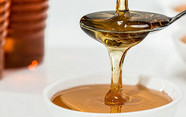
Tipping the Scales
Alternatives to environment-damaging paint additives may come from an unlikely source: the beauty of bugs.
The vibrant orange of a toucan’s beak. The emerald green of a turtle’s shell. The striking red of a field of tulips. Nature is full of stunning examples of mesmerizing color and beauty – as they say, “nature does it best.” Attempts to mimic these tones is an active area of research, gifting today’s scientists with an ever-growing library of synthetic compounds for application in food, beverages, paint, cosmetics and beyond.
But, as the high-carbon footprint (and toxicity) of many of these pigments becomes more apparent, the demand for more environmentally friendly alternatives grows stronger. Did you know that titanium dioxide – prized for its whiteness – contributes almost 75 percent of a paint can’s carbon footprint?
Inspired by such revelations, Andrew Parnell and colleagues set out to find an alternative (1). The Cyphochilus beetle, noted for its opaque, white scales, has proven an unusual specimen; its color can be attributed to light scattering (where refraction and reflection of light inside the scale is responsible for its color, shade, tone, and hue) rather than the result of color pigments.
To avoid damaging the beetle’s delicate scales, the team used X-ray nanotomography – a non-invasive approach – to study the three-dimensional nanostructure. “The first thing we noticed was that the structure was continuous,” says lead author Stephanie Burg. From there, the team generated two hypotheses: firstly, that the structure was likely established at a single point in time during the beetle’s development; and secondly, that this process might be easily replicated and reproduced.
To test the latter, the researchers coupled advanced modeling software with liquid-liquid phase separation technology to create a synthetic variant of the scale, comprising a highly reflective (~94 percent) white film. “It turns out that you can get back the exact same response from our model that you get from the beetle scale,” says Burg. Now come the challenges inherent to translating these findings into environmentally sustainable products. “We’ve had some promising preliminary results, but formulation chemistry is a difficult thing to crack,” says Parnell.
While tackling that challenge, Parnell has found additional inspiration in the form of Parides sesostris – a vibrant-green butterfly. “We’re keen to fully grasp this concept of synthetic iridescence by studying a variety of organisms,” he says. “A whole plethora of different architectures exist. We are just scratching the surface at present.” No pun intended.
In the spirit of collaboration, the group are now putting together a paper that will allow others to manipulate the data obtained from these studies. “We want people to develop their own models, exploring aspects of the problem we haven’t looked into,” says Parnell.
So why did the beetle evolve to be ultra-white? Parnell has a number of theories – “But that’s a puzzle for another day.”
- SL Burg et al., “Liquid-liquid phase separation morphologies in ultra-white beetle scales and a synthetic equivalent”, Nat Communications Chemistry 2, 100 (2019). DOI: 10.1038/S42004-019-0202-8
Having thrown myself into various science communication activities whilst studying science at University, I soon came to realize where my passions truly lie; outside the laboratory, telling the stories of the remarkable men and women conducting groundbreaking research. Now, at Texere, I have the opportunity to do just that.

















